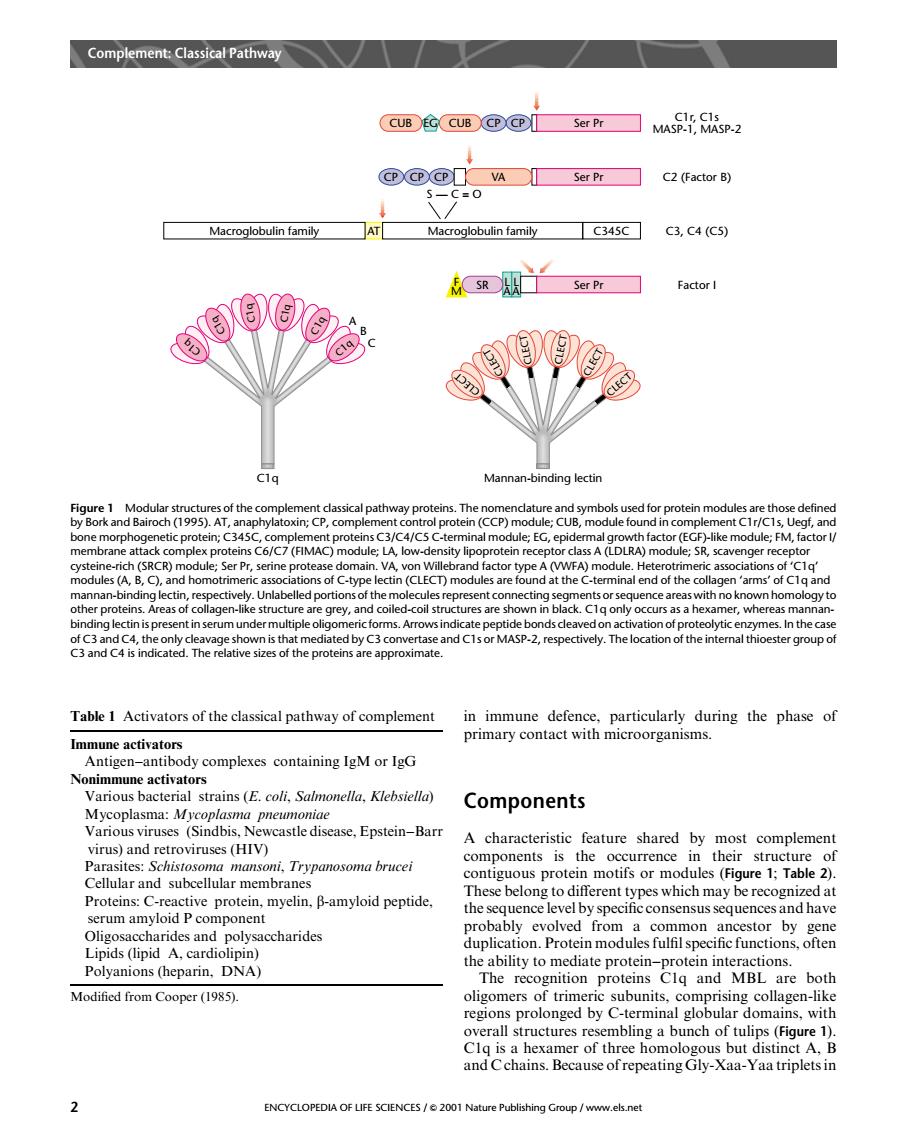正在加载图片...

CUBEC CUBC@C①Ser Pr☐wMp.2 VA Ser Pr☐ C2(Factor B) 0 Macroglobulin family Macroglobulin family C345Cc3,c4(C5) Ser Pr -binding lectin teins C6/C7 (FIMAC)m LA low grey.and coiled-coil struc ner,whereas the pro Table 1 Activators of the classical pathway of complement in immune defence,particularly during the phase of primary contact with microorganisms. Immune activators Antigen-antibody complexes containing IgM or IgG No strains (e coli salmonella klebsiellay Mycoplasma:Mycoplasma pneumoniae Components Various viruses (Sindbis.N wcastle disease.Epstein-Barr rus)and A characteristic feature shared by most complement i.Trypanosoma bruce protein motifsor modules (Figure Table2). Proteins:C-reactive protein,myelin,B-amyloid peptide. These belong to different types which may be recognized at serum amyloid P component the sequence level by specific consensus sequences and have Oasatart.andioolcthandc the ability to mediate pro S. tein n.DNA) The recognition proteins Clq and MBL are both Modified from Cooper(1985). oligomers of trim regions prolonged by s but distinet A.B andCchains.Because ofrepeating Gly-Xaa-Yaa tripletsin ENCYCLOPEDIA OF LIFE SCIENCES/ ublishing Group/www.els.netin immune defence, particularly during the phase of primary contact with microorganisms. Components A characteristic feature shared by most complement components is the occurrence in their structure of contiguous protein motifs or modules (Figure 1; Table 2). These belong to different types which may be recognized at the sequence level by specific consensus sequences and have probably evolved from a common ancestor by gene duplication. Protein modules fulfil specific functions, often the ability to mediate protein–protein interactions. The recognition proteins C1q and MBL are both oligomers of trimeric subunits, comprising collagen-like regions prolonged by C-terminal globular domains, with overall structures resembling a bunch of tulips (Figure 1). C1q is a hexamer of three homologous but distinct A, B and Cchains. Because of repeating Gly-Xaa-Yaa triplets in F M C1r, C1s MASP-1, MASP-2 CP CP Ser Pr CP CP C2 (Factor B) CP Ser Pr CUB EG CUB VA C345C C3, C4 (C5) SR Ser Pr Factor I Macroglobulin family AT Macroglobulin family L A L A CLECT CLECT CLECT CLECT CLECT CLECT C1q C1q C1q C1q C1q C1q C1q Mannan-binding lectin A B C S — C = O Figure 1 Modular structures of the complement classical pathway proteins. The nomenclature and symbols used for protein modules are those defined by Bork and Bairoch (1995). AT, anaphylatoxin; CP, complement control protein (CCP) module; CUB, module found in complement C1r/C1s, Uegf, and bone morphogenetic protein; C345C, complement proteins C3/C4/C5 C-terminal module; EG, epidermal growth factor (EGF)-like module; FM, factor I/ membrane attack complex proteins C6/C7 (FIMAC) module; LA, low-density lipoprotein receptor class A (LDLRA) module; SR, scavenger receptor cysteine-rich (SRCR) module; Ser Pr, serine protease domain. VA, von Willebrand factor type A (VWFA) module. Heterotrimeric associations of ‘C1q’ modules (A, B, C), and homotrimeric associations of C-type lectin (CLECT) modules are found at the C-terminal end of the collagen ‘arms’ of C1q and mannan-binding lectin, respectively. Unlabelled portions of the molecules represent connecting segments or sequence areas with no known homology to other proteins. Areas of collagen-like structure are grey, and coiled-coil structures are shown in black. C1q only occurs as a hexamer, whereas mannanbinding lectin is present in serum under multiple oligomeric forms. Arrows indicate peptide bonds cleaved on activation of proteolytic enzymes. In the case of C3 and C4, the only cleavage shown is that mediated by C3 convertase and C1s or MASP-2, respectively. The location of the internal thioester group of C3 and C4 is indicated. The relative sizes of the proteins are approximate. Table 1 Activators of the classical pathway of complement Immune activators Antigen–antibody complexes containing IgM or IgG Nonimmune activators Various bacterial strains (E. coli, Salmonella, Klebsiella) Mycoplasma: Mycoplasma pneumoniae Various viruses (Sindbis, Newcastle disease, Epstein–Barr virus) and retroviruses (HIV) Parasites: Schistosoma mansoni, Trypanosoma brucei Cellular and subcellular membranes Proteins: C-reactive protein, myelin, b-amyloid peptide, serum amyloid P component Oligosaccharides and polysaccharides Lipids (lipid A, cardiolipin) Polyanions (heparin, DNA) Modified from Cooper (1985). Complement: Classical Pathway 2 ENCYCLOPEDIA OF LIFE SCIENCES / & 2001 Nature Publishing Group / www.els.net